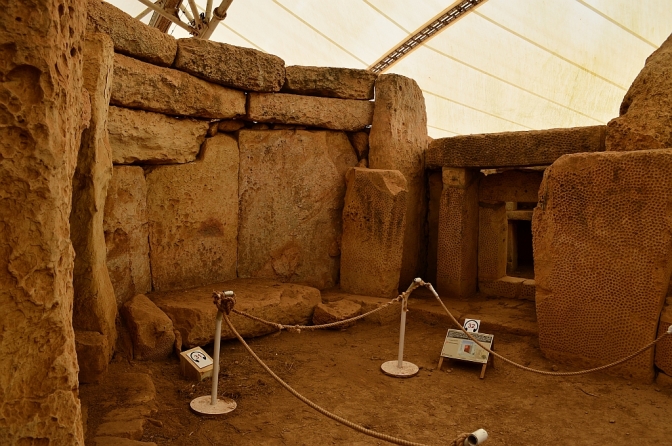„The Megalithic Temples of Malta (Ġgantija, Ħaġar Qim, Mnajdra, Skorba, Ta’ Ħaġrat and Tarxien) are prehistoric monumental buildings constructed during the 4th millennium BC and the 3rd millennium BC. They rank amongst the earliest free-standing stone buildings in the world and are remarkable for their diversity of form and decoration. Each complex is a unique architectural masterpiece and a witness to an exceptional prehistoric culture renowned for its remarkable architectural, artistic and technological achievements.“ (UNESCO)

After disappointingly failing to reserve tickets for the Ħal Saflieni Hypogeum and thus probably missing out on a fascinating experience, we decided to spend a day learning about the rich prehistoric heritage of the island by visiting the Tarxien temple and Mnajdra and Ħaġar Qim sites.


There are numerous prehistoric sites scattered around Malta that share the concept, material used (corraline limestone for external walls and softer globigerina limestone for internal sections of temples), architectural and spatial elements such as forecourts, trilithon entrance doorways and apses as well as decorative elements – usually containing vegetative or animal motives. Still, each of them is unique in its own way, placed in a particular context or on a different location, telling a fascinating story of its own.
The first site of the day was the Tarxien temple. The complex is situated in the middle of a town neighborhood and is surrounded from all sides with modern urban development, making for a really fascinating sight.
 The complex consists of three separate but attached temple structures built between 3600 and 2500 BC and was used, according to research, for rituals that probably involved animal sacrifice. It is the most richly decorated of Maltese temples, with reliefs of domestic animals and spirals, statues and altars, many of whose originals are kept in the National Museum of Archaeology in Valletta.
The complex consists of three separate but attached temple structures built between 3600 and 2500 BC and was used, according to research, for rituals that probably involved animal sacrifice. It is the most richly decorated of Maltese temples, with reliefs of domestic animals and spirals, statues and altars, many of whose originals are kept in the National Museum of Archaeology in Valletta.


 At first sight, with structures and stones of different sizes and shapes scattered among the flowers, the complex seemed (to our untrained eyes, at least) like a playground that the children left in a hurry, leaving behind toys and sandcastles. However, upon entering the complex and focusing on the structures and their purpose with help of educational drawings and tables placed around the site, we soon realized that each stone, hidden object, hole or engraving has a clear and important purpose in the majestic whole.
At first sight, with structures and stones of different sizes and shapes scattered among the flowers, the complex seemed (to our untrained eyes, at least) like a playground that the children left in a hurry, leaving behind toys and sandcastles. However, upon entering the complex and focusing on the structures and their purpose with help of educational drawings and tables placed around the site, we soon realized that each stone, hidden object, hole or engraving has a clear and important purpose in the majestic whole.


After leaving Tarxien, seriously impressed with what we saw, we continued our planned journey around the island by visiting the Ħaġar Qim and Mnajdra sites. Dating from around 4000 BC, the two temples are located some 500 meters from one another, on a remote plain two kilometers away from the villages of Qrendi and Siġġiewi. And they are absolutely breathtaking.

Ħaġar Qim and Mnajdra are spectacularly situated at the edge of the island, surrounded with nothing but rolling plains, wild flowers, pathways, sea and the open skies. The combination of massive stone structures and those natural elements creates a surreal, mystic atmosphere accentuated by the fact that parts of the complexes were specially designed and aligned to mark or let pass rays of sun on the first day of each season: spring and autumn (the Equinoxes) and summer and winter (the Solstices). Never before and nowhere before have I felt such awe and respect towards Nature and felt so humbled by it then while observing the dramatic sight of those giant, mystical stones in cloudy weather. As we approached the sites by a wild pathway, whipped by strong wind, we felt bare, unprotected from Nature that could do with us as it pleases.

Once we entered the structures, however, the large stones and remains of chambers made us feel safe and sheltered, and we could only presume that our predecessors must have felt the same way.


According to the Maltese folklore, island temples have been built by giants. I love such explanations that show people being so amazed with particular feats in history that they considered them divine interventions, but in this case, I could almost believe that the folklore is true. Because I know too little about the way of life or technical and cultural feats of people living on Malta seven thousand years ago, I found it hard to relate to them in terms of heritage continuity which is why these structures, enormous in size, in their dramatic settings, seemed as if they were built by mythological creatures, gods or beings from outer space.


The initial perplexion soon gave way to a different feeling, one of serenity and calm, especially once we entered deeper into the temples and felt the familiarity in terms of what these structures were meant to be: buildings as shelters, as places of worship, of communities, places for family. Buildings of life and civilization. It was the feeling we understood, feeling connected to the very source of our culture and humanity itself.



I never knew you could find these on Malta.
Yes, and they are really fascinating. Such treasure!
Inspiring and truly unforgettable!
You are right, a place of wonders 🙂 Thank you for your comment!